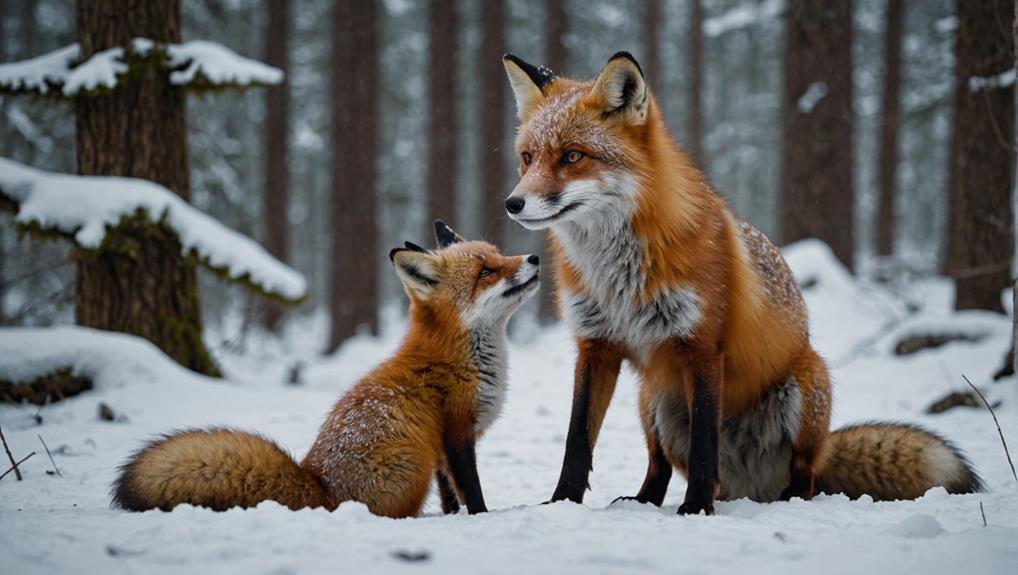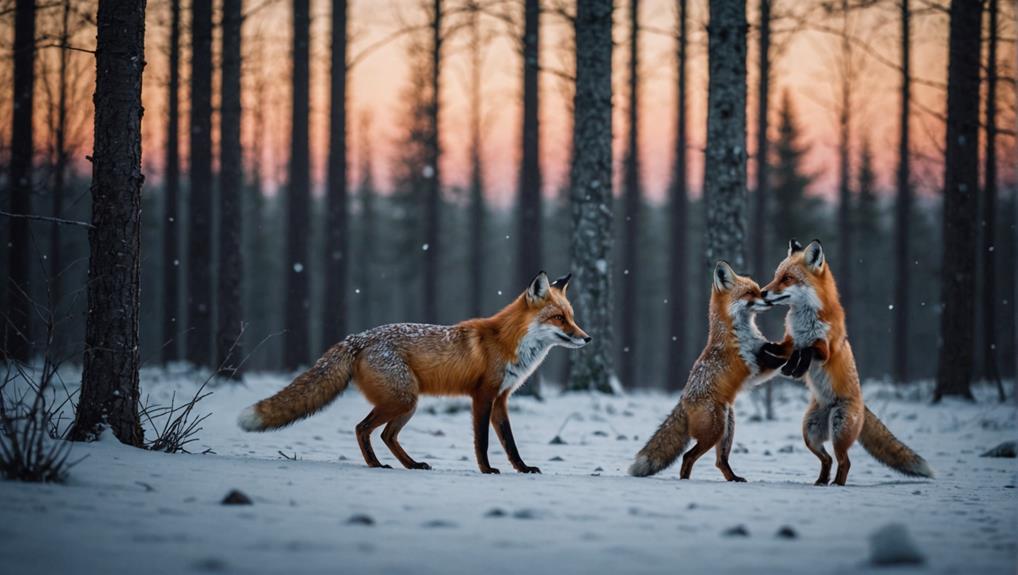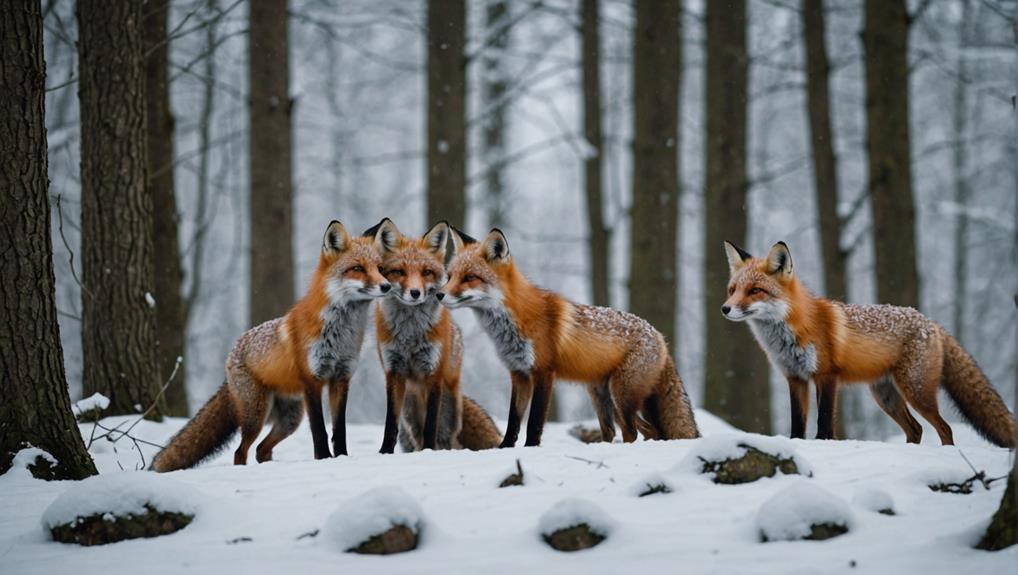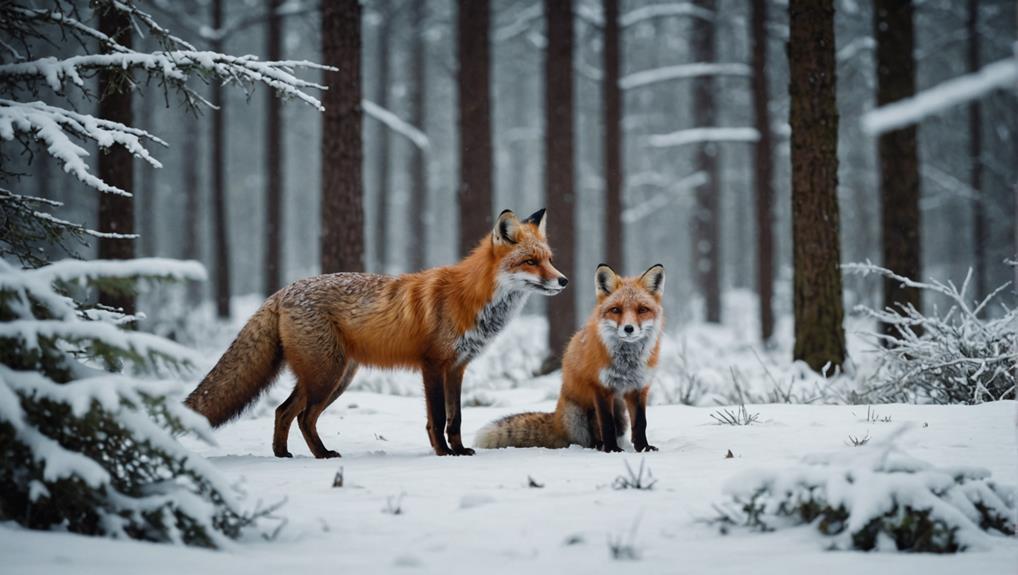Red and Arctic foxes have some pretty fascinating behavior differences that stem from their unique lifestyles! Red foxes are clever and adaptable, living in various environments from forests to cities, and they're known for stealthy hunting techniques. On the flip side, Arctic foxes thrive in the chilly tundra, often pouncing to catch their meals in the snow. They form strong bonds with their mates, while red foxes usually have a more casual romantic life. Communication varies too—red foxes have a whole chorus of sounds, whereas Arctic foxes stick to a smaller set of calls. Curious about more intriguing facts?
Contents
Physical Characteristics
When you look at foxes, their physical characteristics reveal fascinating adaptations to their environments. Red foxes, standing 14 to 20 inches tall and weighing between 10 and 30 pounds, sport a vibrant reddish-brown coat that's often flecked with gray or black. Their bushy tails, which can reach up to 16 inches, aren't just for show; they help with balance and warmth, making these little guys quite the sight to behold! This adaptability allows red foxes to thrive in various environments, from urban areas to forests, showcasing their impressive survival skills in changing landscapes habitats and distribution of red foxes.
Now, take a peek at Arctic foxes. These smaller foxes stand only 10 to 12 inches tall and weigh 8 to 15 pounds. Their stunning all-white coat serves as perfect camouflage against the snowy backdrop, and they've got smaller ears and a shorter snout to keep warm in those chilly Arctic conditions.
When summer rolls around, their fur changes to a blue-grey, making them stylish in every season!
Both red and Arctic foxes showcase how nature's design is all about survival. Whether you're admiring the fiery hues of red foxes or the elegant white of Arctic foxes, their physical characteristics beautifully reflect their unique lifestyles. Isn't nature just amazing?
Habitat Preferences
Foxes exhibit distinct habitat preferences that reflect their adaptability and survival strategies. You'll notice how different environments suit each type of fox. While the red fox population thrives in various landscapes, including forests and grasslands, Arctic foxes stick to their icy homes.
Highly favored habitats for red foxes provide essential food and shelter needs. Here's a quick look at their preferences:
- Red Foxes: These clever critters can be found in forests, grasslands, and even urban settings! They make dens in soil or vegetation, showing their versatility.
- Arctic Foxes: In contrast, Arctic fox dens are typically burrows in the snow, providing warmth in those chilly tundra regions.
- Diet Influence: The habitat preferences of each species are closely tied to their diets. Red foxes are omnivorous, foraging year-round, while Arctic foxes depend heavily on lemmings and scavenged food.
Understanding these habitat choices helps you appreciate the unique survival tactics of both foxes. Whether you're rooting for the adaptable red fox or the resilient Arctic fox, their homes play a significant role in their lives.
Communication Methods

When you think about how foxes communicate, it's pretty fascinating! They use a mix of vocalizations, scent marking, and body language to get their messages across.
For instance, red foxes are known for their diverse range of vocalizations, which can include barks, screams, and howls, often used in social interactions and mating calls.
Fox species exhibit fascinating adaptations in their communication methods as well. From the playful tail wags of red foxes to the sharp yaps of Arctic foxes, these clever critters have a whole toolkit of tricks to let each other know what's going on in their world.
Vocalizations and Sounds
A fascinating aspect of fox behavior is their vocalizations, which include barks, screams, and howls.
These sounds play a significant role in communication, helping foxes express themselves effectively. Did you know there are some key differences in how red and arctic foxes vocalize?
Here's a quick breakdown:
- Red Foxes: They've up to 28 distinct calls! This variety allows them to convey a range of messages, from alerts to friendly greetings.
- Arctic Foxes: They stick to around 12 basic vocalizations, often using barks, whines, and screams, especially during mating season. It's like their version of a love song!
- Social Interaction: Both species not only use sounds but also body language to connect with each other, expressing emotions and intentions.
Scent Marking Techniques
Scent marking techniques are crucial for both red and Arctic foxes, serving as a primary means of communication within their territories.
Imagine walking through a forest and sensing the stories left behind by these clever creatures. Both species use scent marking from glands in their paws to leave their unique signatures.
Red foxes often rely on urine marking, which not only establishes territory but also lets others know about their status and readiness to mate. It's like a little social announcement!
Arctic foxes get in on the action too, using a mix of urine and glandular secretions to communicate their presence. This helps them attract potential mates or warn off rivals.
As you can see, scent marking isn't just for fun; it's a crucial part of their social structure. Dominant foxes tend to mark their territory more frequently, sending a clear message to others: "This is my turf!"
The distinct scents left behind offer valuable information about a fox's identity, reproductive status, and even their health.
Body Language Signals
Body language signals play an essential role in how red and Arctic foxes communicate with each other. These signals help them express their feelings and intentions, creating a unique form of interaction.
Here are three key body language signals to look out for:
- Tail Position: Both red and Arctic foxes use their tails to convey emotions. A raised tail means excitement, while a lowered tail can signify submission or fear.
- Posture and Gait: Red foxes often strut around confidently when they feel secure. In contrast, Arctic foxes might move more cautiously, reflecting their vulnerability in harsh conditions.
- Playful Behavior: In social settings, Arctic foxes engage in playful antics to strengthen their bonds, while red foxes tend to be more solitary, relying on visual and vocal cues.
Understanding these body language signals helps you appreciate the different ways red and Arctic foxes connect with their surroundings and each other.
Hunting Strategies
When you think about how foxes hunt, it's fascinating to see the differences between red foxes and Arctic foxes.
Red foxes, with their stealthy moves, are always on the lookout for a variety of prey, while Arctic foxes are more about patience and endurance in their chilly homes.
As the seasons change, so do their hunting strategies and food choices, making it clear that these clever critters have some interesting tricks up their furry sleeves!
Prey Selection Differences
Frequently, the hunting strategies of red and Arctic foxes highlight their unique adaptations to different environments and prey availability.
You might be surprised to learn how these two species differ in their prey selection. Here are three key differences:
1. Diet Variety: Red foxes love a diverse menu, munching on small mammals, birds, insects, fruits, and even some veggies.
In contrast, Arctic foxes mainly focus on small rodents, like lemmings, and aren't shy about scavenging carrion when needed.
2. Hunting Techniques: Red foxes rely on stealth and sharp hearing, picking up sounds from up to 42 feet away.
Meanwhile, Arctic foxes often put their endurance to the test, using a unique pouncing technique to catch prey hiding under the snow.
3. Seasonal Strategies: Food availability shapes their hunting habits.
Red foxes forage year-round, while Arctic foxes store food during warmer months to prepare for the bitter winter.
Understanding these prey selection differences can help us appreciate how red and Arctic foxes thrive in their respective environments.
Isn't nature fascinating?
Hunting Techniques Comparison
In comparing the hunting techniques of red and Arctic foxes, you'll notice distinct strategies that reflect their adaptations to different environments. Red foxes, for instance, prefer stealth-based hunting.
Picture them quietly stalking their prey—small mammals, birds, or insects—before launching a sudden ambush. They're quite the acrobats of the animal kingdom, using their flexible foraging skills to thrive in various habitats.
On the other hand, Arctic foxes embrace endurance hunting. During the chilly winter months, when food is harder to find, these little furballs chase lemmings and birds over longer distances.
Imagine running a marathon just to catch lunch! Plus, they've got a knack for scavenging, often feasting on leftovers from polar bears—now that's what you call a silver lining in a tough environment.
Both species rely on their incredible hearing to detect prey, with red foxes having the edge—they can hear sounds from up to 42 feet away!
Seasonal Food Availability
Hunting strategies in both red and Arctic foxes are heavily influenced by seasonal food availability. You'll notice that their approaches differ quite a bit based on what's on the menu.
Here's how each species adapts:
- Red Foxes: They've got a diverse diet. From small mammals to fruits, their omnivorous nature lets them switch tactics based on what's around.
- Arctic Foxes: These little guys depend mostly on lemmings and other small rodents. In winter, they get creative, scavenging leftovers from polar bears. Talk about resourceful!
- Food Storage: Arctic foxes often stash food during warmer months to survive the harsher winters when hunting becomes tough.
Red foxes thrive in various environments, even urban areas, thanks to their flexible foraging.
Meanwhile, Arctic foxes stick to tundra habitats, relying on their endurance to chase prey.
It's fascinating how both species use their keen senses but in different ways. While red foxes prefer stealth, Arctic foxes are all about stamina.
Mating Rituals

During the breeding season, Arctic and red foxes engage in distinct mating rituals that reflect their unique social structures. Arctic foxes form strong, monogamous pairs during this time. These devoted couples stick together until their adorable kits are ready to explore the world, usually around 10-12 weeks old. With an average litter size of 11 kits, they sure know how to keep things lively!
On the other hand, red foxes have a more laid-back approach. They often form temporary pair bonds that last just for the mating season. Their mating rituals include playful vocalizations and scent marking, making it quite the social affair. Picture a couple of foxes enjoying a little game of tag—it's not just fun; it's part of their courtship!
In Arctic fox families, the males step up by providing food and protection for the female and her kits. Isn't that sweet?
These rituals might differ, but they all lead to the same goal: ensuring the next generation thrives. So next time you think of foxes, remember their unique ways of finding love and building families, and you'll find it hard not to smile!
Seasonal Adaptations
Foxes not only have unique mating rituals but also remarkable ways of adapting to the changing seasons. When you think about seasonal adaptations, consider how these clever creatures change their behaviors as the weather shifts.
- Winter Warriors: Arctic foxes become more active during winter, taking advantage of the snow to hunt lemmings. It's like they've got a secret winter menu!
- Summer Siesta: In the warmer months, these foxes seek shade, becoming less active to avoid overheating. Their fur even changes to a cool blue-grey—talk about a summer wardrobe!
- Red Fox Flexibility: Red foxes, on the other hand, are year-round hunters. They adjust their diets based on what's available, munching on fruits and insects when it's warm, and focusing on small mammals when it gets chilly.
Both Arctic and red foxes have ingeniously developed distinct behaviors to tackle seasonal temperature changes.
While Arctic foxes rely on their thick fur for warmth, red foxes exhibit adaptability, finding shelter in various environments.
Nature sure has its way of providing these amazing creatures with the tools they need to thrive!
Social Dynamics

In the fascinating world of fox social dynamics, red foxes exhibit remarkable adaptability in their social structures, often opting for solitary lives or forming small family groups. This flexibility allows them to thrive in various environments.
Unlike red foxes, Arctic foxes usually stick together, forming strong pair bonds. They share dens during the chilly winter months, fostering teamwork as they raise their adorable kits.
When it comes to territory, red foxes are quite the artists, marking their domain with scents to assert their presence. It's like leaving a calling card!
On the other hand, Arctic foxes have smaller home ranges, becoming familiar with their local prey and surroundings.
Both species communicate in fascinating ways, using vocalizations, body language, and scent marking. Arctic foxes, for instance, get vocal during mating season, inviting their partners with sweet calls.
In the end, whether you're a red fox enjoying the freedom of solo adventures or an Arctic fox snuggling up with your mate, these social dynamics highlight the beauty of their unique lifestyles.
After all, in the wild, every relationship matters, whether it's with family or territory!
Final Thoughts
So, whether you're enchanted by the fiery red fox darting through the woods or captivated by the resilient arctic fox braving the snowy tundra, both have their own unique charm. They remind us of the beauty and diversity in nature, like characters in a beloved storybook. By understanding their behaviors, we can appreciate these clever creatures even more. After all, isn't it amazing how nature crafts such different paths for its furry little protagonists?














